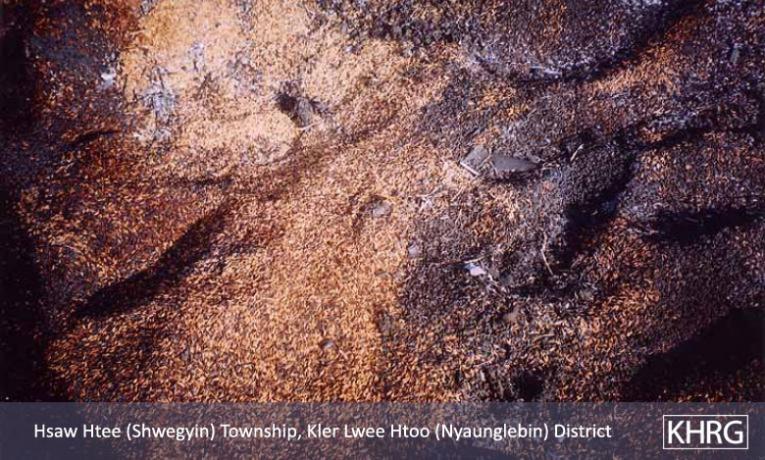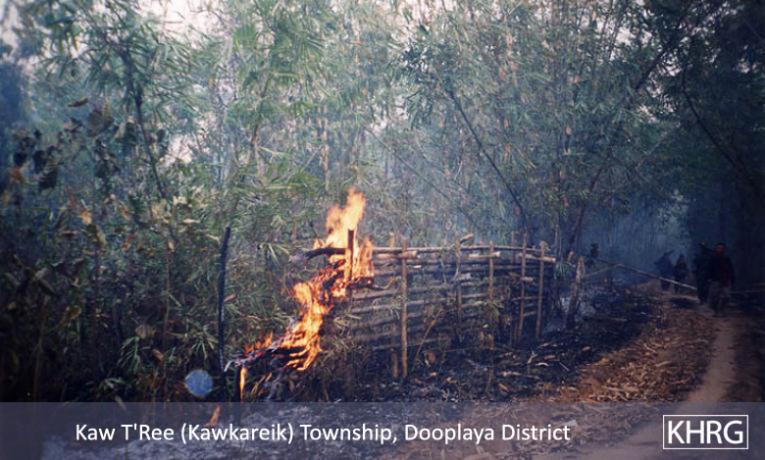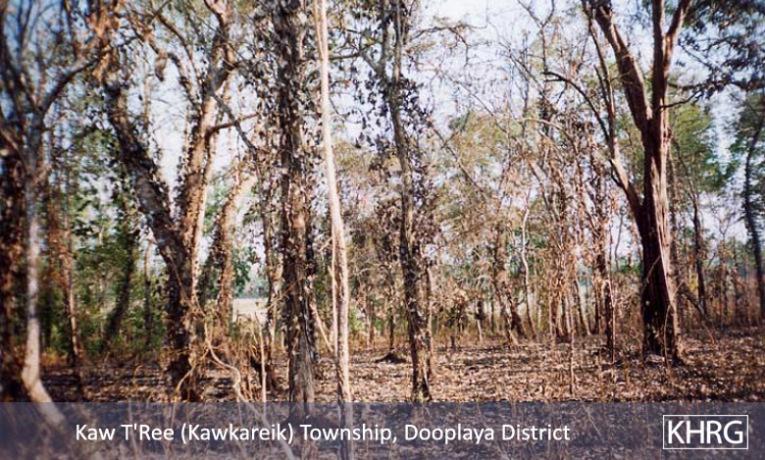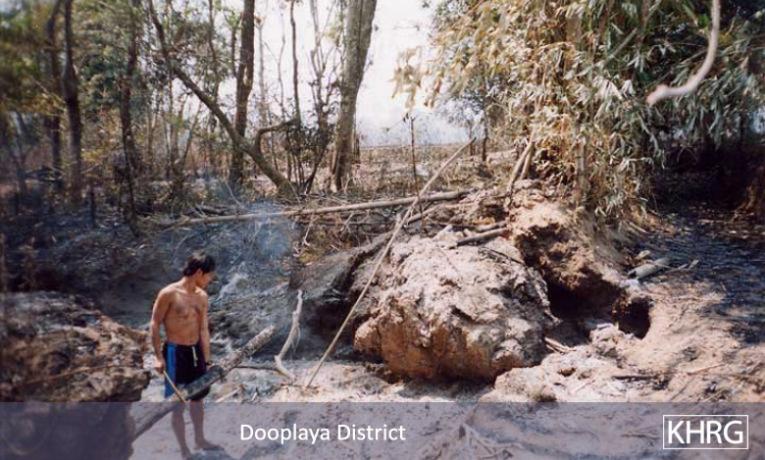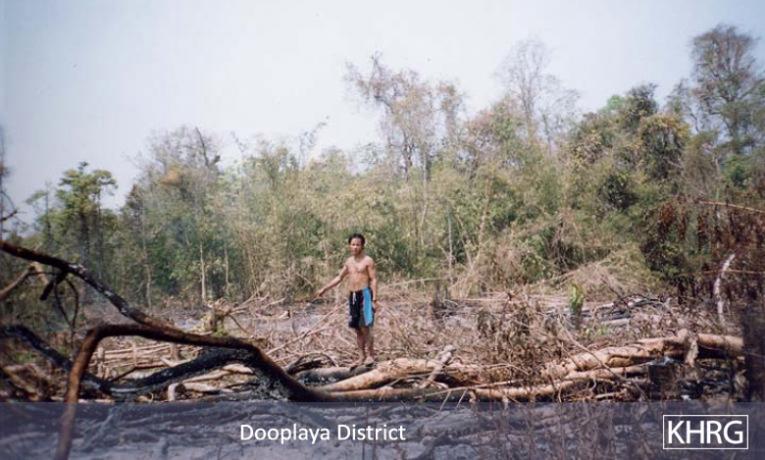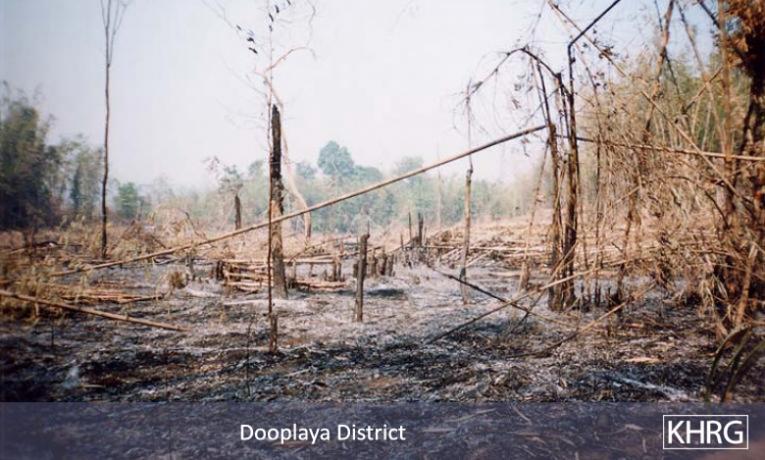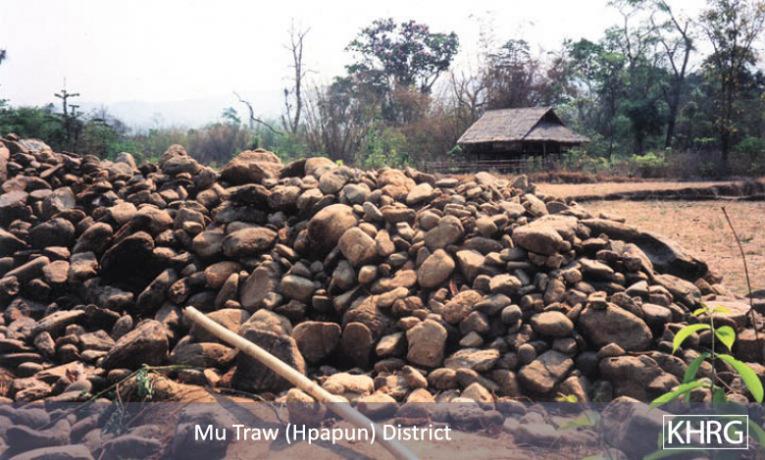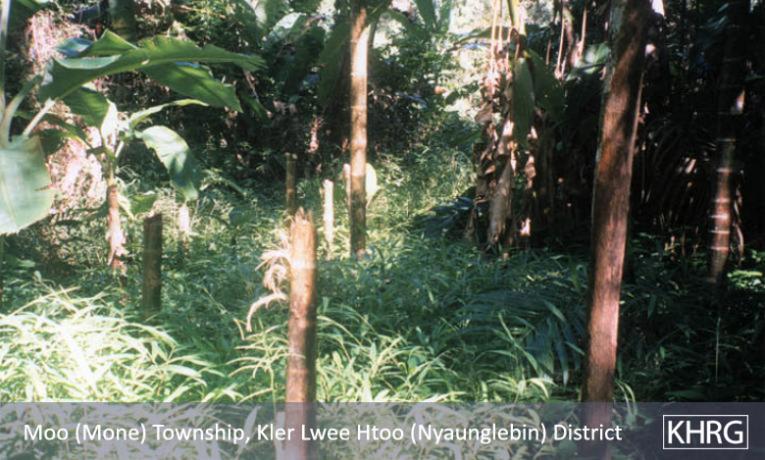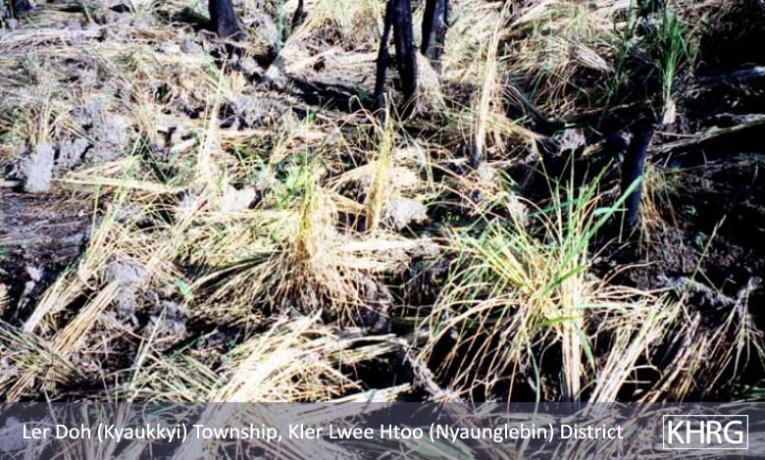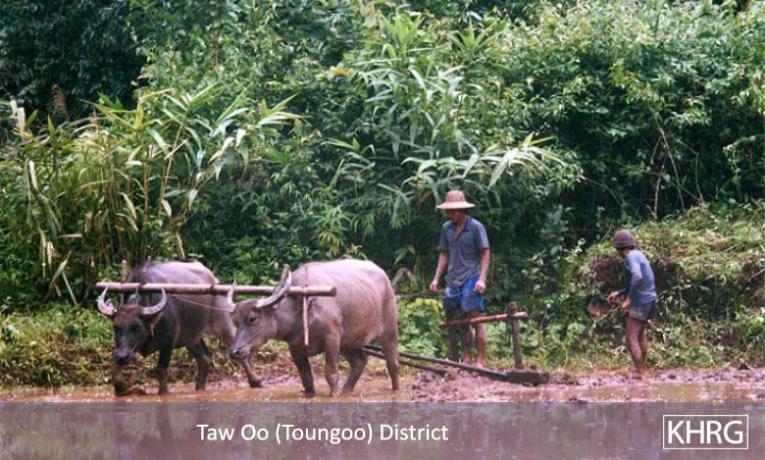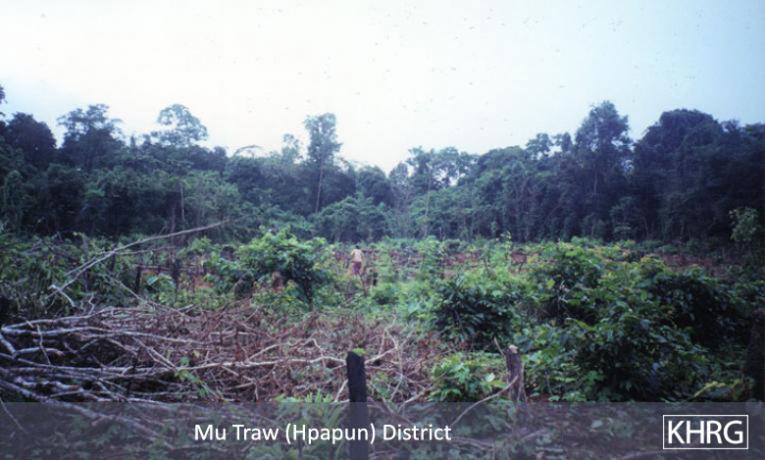Photos #7-1, 7-2: In January 2005, SPDC soldiers from LIB #434 began rebuilding the Ka Ma Maung – Papun vehicle road (see map of Papun district) between Kwih Si and Ma Htaw villages. On January 11 th the soldiers gathered stones from the Tee Mo Pweh river. They also gathered stones from a village irrigation dam used to irrigate five people's ricefields, and removed the stones used to block the flow of irrigation water until ploughing time; as a result, the dam and the water supply were destroyed. The soldiers laid the stones out in the villagers' ricefields, staked out in kyin (one kyin is 100 cubic feet, staked out as ten feet square by one foot deep), as shown in these photos taken on January 13. Later, they drove a truck in over the ricefields, destroying several irrigation control dikes, loaded most of the stones and took them away to the road. They left behind a large number of scrap stones, which the farmers then had to clear from their fields. Though the villagers complained to the officers about all the damage, nothing was done and no compensation was given. [Photos: KHRG researcher]
Photos #1-20, 1-21: On November 18 th 2004, SPDC LIB #589 began burning villages in the Yah Aw area of Shwegyin township, Nyaunglebin district (see Section 1, A Short Story in Pictures ). Photo 1-20 was taken on November 23 rd 2004 from the hill fields of one of the villages already burned. Beyond the next ridge the rising smoke is from SPDC LIB #589 troops burning the hill fields and field huts near Khaw Hta village. In the distance, the sound of shots was also audible as SPDC soldiers shot the villagers' pigs and cattle for food. A thin column of smoke is faintly visible in the centre of photo 1-21 ; it is smoke rising from the paddy storage barn of the Christian pastor of K'Hee Day village. LIB #589 soldiers had set it alight, and paddy can smoulder for days. [Photos: KHRG researcher]
Photos # 1-33, 1-34, 1-35, 1-36, 1-37, 1-38, 1-39, 1-40: SPDC columns appear to have deliberately timed their attack on hill villages in Shwegyin township in November/December 2004 (see Section 1, A Short Story in Pictures ) to interfere with the rice harvest, because they not only burned villages but systematically sought out and destroyed paddy storage barns hidden in the forest and farmfield huts with their piles of harvested paddy, then stayed around the villages to prevent villagers from returning to complete their harvest. Photo 1-33 shows the farmfield hut of Pa T--- from Khaw Hta, burned along with the paddy ( photo 1-34 ) he had already harvested. The remains of B---'s paddy storage barn, with his paddy still smouldering, are shown in photo 1-35 , while photo 1-36 shows the burned patch of ground where his farmfield hut used to be; in the foreground he has piled the only paddy he could salvage from the ashes. Both were burned by a combined column of LIB #587, LIB #589 and IB #57. Saw P--- lost 70 baskets of newly harvested paddy and all of his farming implements when LIB #350 burned his field hut (photos 1-37 and 1-38 ). The burned ground in photo 1-39 used to be the farmfield hut of a Yah Aw villager. Photo 1-40 provides a closeup view of Pa D---'s partial paddy harvest, now little more than a mound of charred and blackened grains. All of these photos were taken between December 6 th and 15 th 2004. [Photos: KHRG researcher]
Photos # 1-41, 1-42, 1-43: These photos show what remained of teacher L---'s rice after an SPDC column from LIB #587, LIB #589 and IB #57 passed through Khaw Hta area and burned villages and farmfield huts in late November 2004, in mid-harvest season. Photo 1-41 shows his unharvested paddy still in the field, in the process of going to seed or being eaten by insects and animals because he couldn't dare return to harvest it while the column remained in the area. Photo 1-42 shows his farmfield hut, burned by the column on November 23 rd along with most of the paddy he had already harvested. All that could be salvaged has now been piled on the mats in the centre of the photo. The column also found and burned his paddy storage barn, leaving nothing but the ashes shown in photo 1-43 . [Photos: KHRG researcher]
Photo #7-3: Karen villagers in Dweh Loh township, Papun district, gathering cane and transporting it to market to sell. Previously these people were able to live by rice farming and keeping plantations and livestock, but since SPDC troops became more active in their area in 2003 their movements became more restricted and their food and belongings were looted or extorted from them. They could no longer produce enough by farming, so they now have to supplement their income through selling cane. This is hard and time-consuming work, cutting it in thick forest high on the hills, hauling it to the river, then transporting it by raft to market. Gathering one load takes an entire day. They can sell one piece of cane for 150 Kyat, making just enough each day to buy rice. This photo was taken in October 2004. [Photo: KHRG researcher]
Photo #7-4: Saw K---, 25, is from L--- village in Than Daung township, Toungoo District. In mid-2004 a column from SPDC IB #92 led by Captain Zaw Zaw Aung destroyed his cardamom plantation, a crucial source of livelihood for villagers in this area. This photo was taken in August 2004. [Photo: KHRG researcher]
Photos # 7-5, 7-6, 7-7, 7-8: On March 22 nd 2004, soldiers from SPDC IB #283 entered Htee Meh Baw village in Kawkareik township, Dooplaya District to demand food from the villagers. Upon returning to their camp, they set fire to the bush along the roadside, a routine Tatmadaw practice to make it more difficult for resistance forces and internally displaced villagers to hide themselves or cross the road. In the process, they also set fire to all the villagers' banana, betelnut, and peppercorn plantations and hill fields lining the road. Photo 7-8 shows one of the peppercorn plantations that was destroyed. Saw M--- and Naw K--- each lost over 1,000 betelnut trees when their plantations burned, while Saw P--- lost over 2,000 betelnut trees. [Photos: KHRG researcher]
Photos # 7-9, 7-10, 7-11, 7-12, 7-13, 7-14: On March 4 th 2004, LIB #549 troops (Battalion Commander Thu Ra Myo Tint commanding) burned a 'killing zone' along the flanks of the Kyaikdon to Lay Po Hta car road in Dooplaya District to protect Maung Maung Sein, the visiting commander of Military Operations Command #12, from ambush as he travelled along the road. The fire quickly raged out of control and destroyed many fields and plantations in the area. These photos taken the next day show Pa K--- from P--- village standing in his burned field ( photo 7-9 ) and inspecting his destroyed irrigation works ( photo 7-10 ), and part of Pa Y---'s betelnut plantation ( photo 7-12 ). Photo #7-11 shows the extent of the burned irrigated-paddy fields. Pa K---'s rain-irrigated field which he had just cleared for the year's planting was also burned ( photos 7-13 and 7-14 ). The cut scrub had not had time to dry fully yet, leading to an incomplete burning which will make planting a proper crop impossible when the rains come. The people of several villages were affected by the fires, but no compensation was paid to the villagers for their loss. [Photos: KHRG researcher]
Photo #7-15: For the past few years the SPDC has been building a car road between Kaw Pu village in Bu Tho township and T'Ku Der village in Lu Thaw township in Papun District. Soldiers from LIB #379 led by company commander Min Lwin Oo destroyed this ricefield near Meh Yeh Kloh village in Bu Tho township by ploughing their bulldozer right through it to clear a path for the road. No consultations with local villagers are held regarding the road, and no compensation is paid. This photo was taken in March 2004. [Photo: KHRG researcher] Photo #7-16: Since the informal ceasefire with the KNLA began in January 2004, the SPDC has continued its road building programme in Karen State in an attempt to strengthen its control over remote areas. In March 2004, soldiers from LIB #434 were ordered to repair the vehicle road between Kwih Si and Ma Hta villages in Dweh Loh township of Papun District. The soldiers dumped this pile of stone in this flat rice field near K--- village, where it lay untouched three months later when this photo was taken in June 2004. It took the owner of the field an entire week to move the stones to a corner of his field so that he could plough it in readiness for planting. In addition to being ordered to perform forced labour maintaining these roads, the villagers living in their paths often find their fields destroyed with no warning and no consultation. [Photo: KHRG researcher]
Photo #6-134: Over 10 plantations of loh trees (a type of palm used for roofing thatch) belonging to Kya Th'Raw village were destroyed in the construction of this vehicle road in Thaton township, Thaton District. Saw T---, a villager from an adjacent village who was ordered to work on the road, told a KHRG researcher, "The Burmese [soldiers] forced the villagers to build the road. It passed through the villagers' loh plantations, but they didn't dare to complain about it. They didn't receive any payment [compensation]." A number of the stumps of the trees that were cut down can still be seen protruding from the road. This photo was taken in January 2004. [Photo: KHRG researcher]
Photos # 10-43, 10-44, 10-45, 10-46: Villagers flee K'Leh Loh village in Lu Thaw township, Papun district to escape an approaching column of Light Infantry Division #55 in January 2004. The column entered their village, burned their paddy storage barns, looted their houses, and killed villager Saw Kloh Po Heh. [Photos: KHRG researcher]
Photo #7-17: This pile of ash and charred paddy is all that remains of a rice storage barn near the IDP hiding site at K--- in Lu Thaw township, Papun District. Soldiers from SPDC Light Infantry Division #55 burned it on December 30 th 2003 as their forces swept through the area in search of IDPs and their food supplies. This photo was taken in January 2004. [Photo: KHRG researcher] Photo #7-18: These are the chopped-off stalks of betelnut trees, whose fruit is a major cash crop in Karen regions. This plantation belonging to Saw B---, 36, from K--- village in Mone township of Nyaunglebin District was cut down by soldiers from SPDC LIB #20 in August 2003. Betelnut trees can take as long as a decade to become productive and bear fruit. SPDC troops in the area cut them down to cut off hill villagers' access to cash and food in hopes that this will force them to move to SPDC-controlled villages. This photo was taken in November 2003. [Photo: KHRG researcher]
Photo #2-12: A villager stands amongst the ashes of his farmfield hut near Klaw Day village in Bu Tho township, Papun District. This hut and another like it were burned by soldiers from Column #2 of SPDC IB #35 in early October 2003. SPDC patrols routinely burn farmfield huts and destroy fields to hamper villagers' access to food. This photo was taken soon afterward. [Photo: KHRG researcher]
Photo #7-19: Longtail trading boats like these are a major livelihood of villagers living along the Tha May (Atayan) river in southern Dooplaya district. However, in July 2003 troops from SPDC LIB #586 and LIB #591 came to the villages along the river saying they had orders from higher military authorities to destroy all trading boats because they were used to transport supplies to the KNLA. They managed to destroy six boats altogether in Kyo Kyaw, Meh T'Pwih and K'Lee Lah villages, but were unable to get their hands on any more and gave up. The boat in the foreground of this photo was one of those destroyed, but the owner rebuilt it and now uses it to transport goods for trade again. Villagers regularly suffer from such arbitrary and erratic decrees of SPDC military officers, which are a major factor destabilising their livelihoods. [Photo: KHRG researcher]
Photos # 5-23, 5-24, 5-25: Saw Pa Kyaw Dah, age 38, from N--- village in Papun District was shot dead by soldiers from SPDC Light Infantry Division #66 on May 29 th 2003. He was working in his hill field planting the paddy seeds for the next harvest when he was spotted and shot on sight. The SPDC is trying to clear villagers out of the hills where he lives, and Army columns often target villagers as they are working in their hill fields where they are far more visible. These photos were taken the day after he was killed. [Photos: KHRG researcher]
Photos # 7-20, 7-21, 7-22, 7-23: These hill fields were prematurely burned by SPDC soldiers in 2003 to prevent villagers being able to plant a proper crop. Before a hill field can be planted, any brush that has grown since it was last used needs to be cut down, dried, and then burned. The burning is normally conducted in April or May once the cut scrub has sufficiently dried out. Burning prematurely produces an uneven burn, leaving clutter of bushes and small trees which makes a complete planting impossible. Without being able to plant the entire field, the villagers are unable to get enough rice to last them until the next harvest. Photos 7-20 and 7-21 show hill fields in Bilin township, Thaton District, prematurely burned on April 3 rd 2003 by SPDC LIB #11 (Battalion Commander Thein Zaw commanding). Photos 7-22 and 7-23 show hill fields near Ho Kay village, Bu Tho township, Papun District, prematurely burned on March 4 th 2003 by SPDC soldiers from LIB #6 and IB #14 (Battalion Commander Thein Htun commanding). These photos were taken in April 2003. [Photos: KHRG researchers]
Photos #7-24, 7-25: SPDC Army soldiers destroyed this paddy barn near P--- village in Papun District in mid-2003. Almost all of the 50 baskets [1,050 kgs. / 2,300 lbs.] of paddy that were inside the barn were rendered inedible after the soldiers poured it on the ground. The owner of the barn, internally displaced villager Saw T---, was only able to salvage four or five baskets [84-105 kgs. / 184-230 lbs.] of the paddy. Once processed into edible rice, this will only last his family of six for one to two months. [Photos: KHRG researcher]
Photo #7-26: These irrigated rice fields near K'Dwee Koh village in Dweh Loh township, Papun District were destroyed by SPDC LIB #434 soldiers who were repairing the nearby Papun to Bilin vehicle road. The soldiers dug earth and stone out of the villagers' fields and the dikes essential to controlling irrigation, then used it to build the road which they rerouted directly through crop fields. They did not consult the villagers or village leaders at all, but villagers did not dare to complain for fear of military retaliation. This photo was taken in March 2003. [Photo: KHRG researcher]
Photos # 7-27, 7-28, 7-29: This is all that remains of the paddy storage barn belonging to Saw K---, 25, and Naw R---, 45, from Saw Mu Plaw village tract in Papun District. It was burned by SPDC troops on January 4 th 2003, destroying 60 baskets [1,260 kgs. / 2,760 lbs.] of paddy as well as their large ceramic jar, machetes, a spade and a saw. The paddy was still smouldering when these photos were taken a week later. [Photos: KHRG researcher]
Photos #7-30, 7-31: Villager T--- from Bilin was stranded upriver on this riverbank in November 2002 because KNLA officer Bper Na Loh had destroyed all of the bamboo and cane rafts which he used to make his livelihood, presumably because he had failed to comply with some KNLA demand. As a result T--- and his family were unable to return downriver to their home or to earn any livelihood, though photo 7-31 shows them making new rafts in the hope of continuing in the future. [Photos: KHRG researcher]
Photos #5-31, 5-32: On November 4 th 2002, Saw L---, Saw P---, and Saw Sha Kaw from D--- village in Lu Thaw township, Papun District left their village to sell bamboo that they had cut. They were spotted by soldiers from SPDC IB #19 who opened fire on them, wounding Saw L--- and killing Saw Sha Kaw. Photo 5-31 shows 27 year old Saw L--- receiving medical attention for the gunshot wounds in his shoulder at a KNU clinic in the area. Photo 5-32 is of Saw Sha Kaw's wife and four children. With her children still too small to do much hard work in the hill fields, it will be difficult for her to grow enough food for her family. SPDC forces routinely shoot villagers on sight in this area, because they have never been able to bring it under their full control. [Photos: KHRG researcher]
Photos # 5-33, 5-34, 5-35, 5-36, 5-37, 5-38, 5-39, 5-40: On October 30 th 2002, a number of villagers from S--- village in northern Lu Thaw township, Papun District, went to harvest the paddy from their hill field at T---. SPDC forces have been trying to depopulate this hill area since 1997 by destroying villages, crops and food supplies and shooting villagers on sight, but thousands of villagers still survive here. At 3:30 pm as the villagers were collecting their harvest, soldiers from LIB #235 crept up on them and opened fire. One of the villagers, 25 year old Saw Ray Bee Wah, was shot dead, and at least five other villagers were injured in the shooting. Photos 5-33 , 5-34 , and 5-35 show Naw L---, 15, who was shot just below her left elbow. Photos 5-36 and 5-37 are of eight-year-old Naw M---, who was shot in the abdomen, the bullet barely missing her kidney. Photos 5-38 and 5-39 show the gunshot wound in the leg of Saw T---, 38. Fortunately for him, the bullet passed right through his leg without hitting the bone. Photo 5-40 shows Saw T---, 20 years old, who was shot in the forearm, having his wound cleaned by a Karen medic. Medics in the area can do little but clean the wounds due to the lack of medicines and clinic facilities. Saw P---, a 32-year-old villager not shown here, was also wounded. The reason so many people were hit is that they must harvest in open hillside fields with no cover, while SPDC troops can creep up in the forest to the very edge of the field without being detected. In these circumstances there is no doubt that they knew they were firing on civilians and children. These photos were taken in November 2002. [Photos: KHRG researcher]
Photo #11-53: People are not the only victims of landmines in Karen State. It is quite common for buffaloes, cattle, and elephants to lose their limbs or lives to landmines. On October 29 th 2002, this buffalo owned by Saw M--- from B--- village, Dta Greh township in Pa'an District stepped on an SPDC landmine beside the Moei River, dying later that same day. No compensation was paid to the owner. [Photo: KHRG researcher]
Photo #7-32: On October 5 th 2002, still too early to harvest, SPDC soldiers from LIB #366 and LIB #368 pulled out and trampled much of the paddy in this field owned by M---, an internally displaced villager from T--- village in Nyaunglebin District. [Photo: KHRG researcher] Photos #7-33, 7-34: Soldiers from SPDC LIB #368 came to this hill field in Ler Doh township of Nyaunglebin District in late September 2002, and pulled many of the paddy stalks out of the ground in order to deliberately destroy the harvest. The field belongs to Saw P--- of D--- village. SPDC Army soldiers systematically target the fields and food supplies of hill villagers when they are unable to catch the villagers themselves, as part of their ongoing campaign to depopulate the hills of Karen State. These photos were taken in October 2002. [Photos: KHRG researcher]
Photos # 5-58, 5-59, 5-60: Saw K---, 27 years old from H--- village in Lu Thaw township of Papun District. On July 24 th 2002 he was taking his betelnut to the market in S--- to exchange it for rice along with numerous other villagers. Villagers from hill areas are always at risk of being intercepted, detained and tortured or forced to porter by SPDC troops, so the group of villagers was being escorted by KNLA soldiers. Along the way they were seen by soldiers from SPDC LIB #255, who opened fire on them. During the ensuing skirmish between the SPDC and KNLA soldiers, Saw K--- received bullet and shrapnel wounds to his buttocks and back. Photos 5-59 and 5-60 show him being treated by one of the Karen medics who were accompanying them. There was no medicine to give him aside from painkillers. The medics were not carrying many medicines, and due to the continued SPDC activity in the area, he could not be transported out of the area to a clinic for proper treatment for several days. [Photos: KHRG researcher]
Photos #7-35, 7-36: On July 16 th 2002, soldiers from LIB #368 (Battalion Commander Kyaw Win commanding) found the displaced villagers' hiding site at M--- in Dweh Loh township of Papun District. As part of their ongoing efforts to flush IDPs out of the hills, the soldiers burned the homes and destroyed the villagers' food supplies, casting the villagers' paddy onto the ground so as to render it inedible. As it was wet season, much of the paddy had germinated after being soaked in the monsoon rains by the time these photos were taken two weeks later. [Photos: KHRG researcher] Photos # 2-31, 2-32, 2-33, 2-34, 2-35, 2-36: A hiding site of internally displaced villagers in Dweh Loh township, Papun District that was destroyed by SPDC soldiers. On July 16 th 2002, soldiers from LIB #368 (battalion commander Kyaw Win commanding) found this site and burned the houses and paddy barns. Most of the houses were burned to the ground and all stores of paddy that were found were cast onto the ground and set alight. Photos 2-34 , 2-35 , and 2-36show how those grains which survived the fire have germinated. These photos were taken in late July 2002 when the villagers returned to their village to see if any of their food or possessions survived the fires. [Photos: KHRG researcher]
Photo #7-37: Shortly after the internally displaced villagers from T--- village in Tantabin Township of Toungoo District cut and cleared this hill field in early 2004, a small unit of troops from LIB #660 built a temporary outpost just a few minutes' walk away – possibly with the purpose of locating and catching the IDPs who cleared the field. The villagers, however, stayed away once the post was there, and were never able to plant this field. This photo was taken in August 2004, when it was already too late to plant. This illustrates the difficulties and uncertainties IDPs face in growing rice; if an SPDC unit loiters nearby at any time during the crop cycle, the entire crop is lost. [Photo: KHRG researcher] Photo #7-38: Villagers in Tantabin Township of Toungoo District ploughing their flat rice fields in August 2004. Owing to the close proximity of an SPDC Army camp, these villagers can only work in these fields whenever the soldiers are not active. When the soldiers are out of their camp on patrol, the villagers do not dare to work these fields for fear of being seen and arrested. [Photo: KHRG researcher] Photo #7-39: This is the hill field of Saw M---, age 43, from T--- village in Lu Thaw township of Papun District. After using 21 baskets of rice seed to plant this field, he had to flee his village with his family of ten due to increasing SPDC activity in the area. They are now internally displaced at D--- and dare not return to tend the field, so this entire crop will be lost. This photo was taken in October 2003. [Photo: KHRG researcher]
Photos #7-40, 7-41: Villagers from Wa Soe and Sho Ser villages, along the Toungoo-Mawchi road route in eastern Toungoo District ( see map ), fled their villages en masse when SPDC forces established a number of new military camps nearby in conjunction with their reconstruction of the Toungoo-Mawchi vehicle road. Shortly after being cleared and planted, these hill fields were abandoned early in growing season because the villagers feared being seen and shot or abused by soldiers moving along the newly reconstructed road. These photos were taken in June 2003. [Photos: KHRG researcher] Photo #7-42: On May 5 th 2003 fighting occurred between KNLA and SPDC soldiers near B--- village, along the Papun - Ka Ma Maung car road in Dweh Loh township of Papun District. The SPDC soldiers blamed the B--- villagers for not preventing the KNLA attack. Though SPDC officers know that villagers are not responsible for such attacks, they routinely retaliate against villagers in order to alienate them from the KNLA. Fearing a violent retaliation, the B--- villagers fled the area, leaving fields like this one cleared but not burned for planting. Without access to their fields, they must now find ways to survive in the forest. By the time this photo was taken in early July 2003, this field should have been burned off and planted. [Photo: KHRG researcher] Photo #7-43: In June 2002 SPDC LIB #5 (Battalion Commander Ko Ko Naing commanding), part of Light Infantry Division #66, built their temporary camp close to this irrigated field near Htee Baw Law village in Dweh Loh township, Papun District. Since that time, the villagers have not dared to return to work this field. This photo was taken in July 2003. [Photo: KHRG researcher]

















